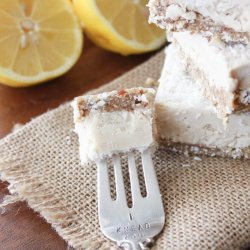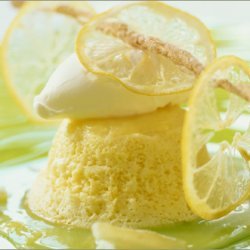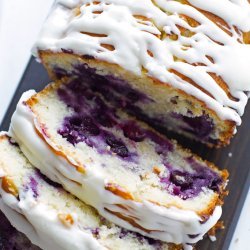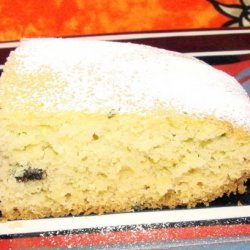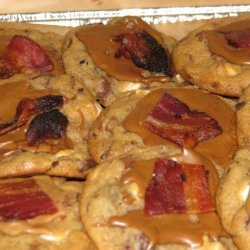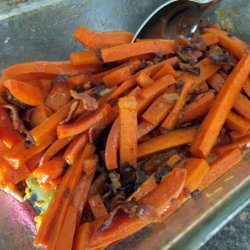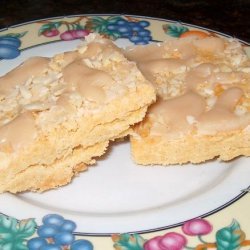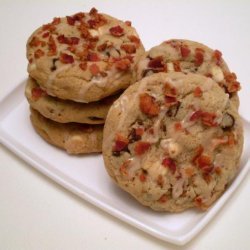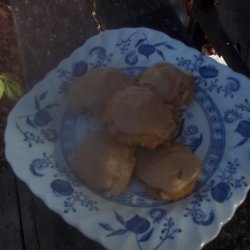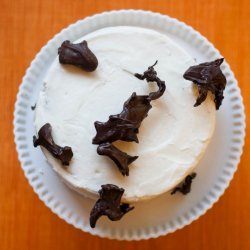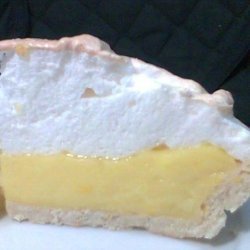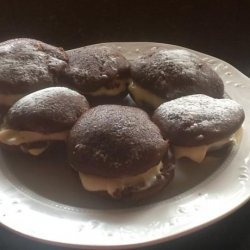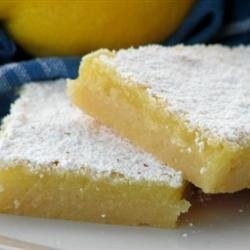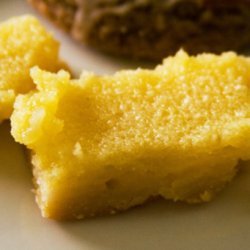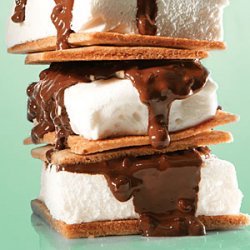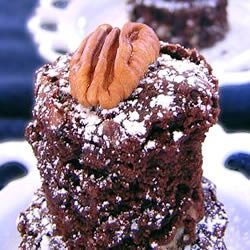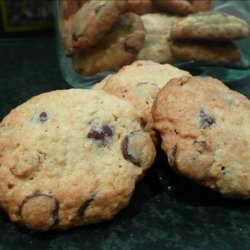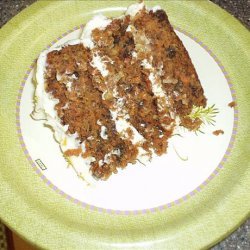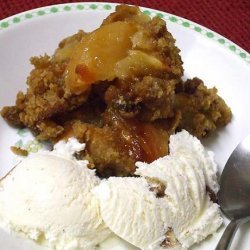Ingredients:
- 3 fl oz (use a liquid measuring cup) lemon juice, freshly squeezed (about 2 1/2 large lemons) (3.25 oz = 94 g)
- pinch of salt
Directions:
- EQUIPMENT: 8-inch by 8-inch by 2-inch baking pan, preferably metal (if using a glass pan, lower the oven temperature 25°F.), bottom and 2 sides lined with an 8-inch by 16-inch strip of heavy-duty aluminum foil.
- Food Processor Method Cut the butter into 1-inch cubes, wrap it, and refrigerate.
- In a food processor with the metal blade, process the sugars for 1 minute or so, until the sugar is very fine. Add the butter and pulse in until the sugar disappears. Add the flour and pulse in until there are a lot of little moist crumbly pieces and no dry flour particles remain.
- Dump the mixture into a plastic bag and press it together. Remove the dough from the plastic bag and knead it lightly, until it holds together.
- Electric Mixer Method or by Hand In Scotland, it is said that the best shortbread is mixed with the fingers and that each woman's fingers lend something distinctive and special to the finished cookie. I find that the texture is more delicate when the dough is mixed with the fingers rather than in a machine. For either method, use superfine sugar for the best texture and be sure to soften the butter.
- In a medium bowl, whisk together the sugars. In a large bowl, cream the butter with the sugars until light and fluffy. With your fingers or with the electric mixer, mix in the flour until incorporated. If using the mixer, add the flour in 2 parts.
- For Both MethodsPlace 1 oven rack in the middle of the oven.
- Preheat oven to 325°F.
- Pat the dough into the prepared pan. Use a fork to prick the dough all over.
- Bake for about 30 to 40 minutes or until the edges are lightly browned and the top is pale golden (do not brown).
- While the shortbread is baking, prepare the Lemon Curd Topping.
- LEMON CURD TOPPING Have a strainer, suspended over a bowl, ready near the range.
- In a heavy noncorrodible saucepan, beat the egg yolks and sugar with a wooden spoon until well blended. Stir in the lemon juice, butter, and salt. Cook over medium-low heat, stirring constantly, for about 6 minutes, until thickened and resembling hollandaise sauce, which thickly coats a wooden spoon but is still liquid enough to pour. (A candy thermometer will read 196°F.) The mixture will change from translucent to opaque and begin to take on a yellow color on the back of a wooden spoon. It must not be allowed to boil or it will curdle. (It will steam above 140°F. Whenever steaming occurs, remove the pan briefly from the heat, stirring constantly to prevent boiling.)
- When the curd has thickened, pour it at once into the strainer. Press it with the back of a spoon until only the coarse residue remains. Discard the residue. Stir in the lemon zest.
- When the shortbread is baked, remove it from the oven, lower the temperature to 300°F., pour the lemon curd on top of the shortbread, and return it to the oven for 10 minutes.
- Cool the lemon curdtopped shortbread completely in the pan on a wire rack. Refrigerate the pan for 30 minutes to set the lemon curd completely before cutting into bars. Place the powdered sugar in a strainer and tap the strainer with a spoon to sprinkle a thick, even coating, entirely covering the lemon.
- Run a small metal spatula between the sides of the pan and the pastry on the 2 sides without the aluminum foil. Use the foil to lift out the lemon curdcovered shortbread onto a cutting surface. Use a long, sharp knife to cut the shortbread first in thirds, then in half the other way, and then each half in thirds. Wipe the blade after each cut.
- The powdered sugar will start to be absorbed into the lemon curd after several hours, but it can be reapplied before serving.
- Store: In an airtight container at room temperature, or in the refrigerator or freezer.
- Keeps: 3 days at room temperature, 3 weeks refrigerated (individually wrapped in plastic wrap to prevent drying), or 3 months frozen.
- Smart Cookie Cooking the topping before pouring it into the shortbread ensures crispness as opposed to the usual pastiness of the pastry.
- Returning the curd to the oven, where it will be exposed to heat without stirring, causes the yolk to rebond, making it firm enough to cut after cooling.
- If each lemon is heated about 10 seconds in a microwave oven on high power and rolled around while pressing on it lightly, it will release a significantly greater quantity of juice.
- An aluminum pan should not be used to prepare the lemon curd because it will react with the egg yolks, turning them chartreuse.
- Sugar raises the coagulation point of the egg yolk. It also protects it from premature coagulation during the addition of the lemon juice. If the juice were added directly to the unprotected yolk, the yolk would partially coagulate and, when strained, a large percentage of it would be left behind in the strainer. Be sure to mix the sugar well with the egg yolks before adding the juice.
Nutrition Facts
| Amount Per 1 Serving | |||
| Calories | 3096.01 Kcal (12962 kJ) | ||
| Calories from fat | 1701.27 Kcal | ||
| % Daily Value* | |||
| Total Fat | 189.03g | 291% | |
|---|---|---|---|
| Cholesterol | 1171.42mg | 390% | |
| Sodium | 565.1mg | 24% | |
| Potassium | 825.94mg | 18% | |
| Total Carbs | 314.23g | 105% | |
| Sugars | 183.76g | 735% | |
| Dietary Fiber | 4.69g | 19% | |
| Protein | 45.01g | 90% | |
| Vitamin A | 2mg | 66% | |
| Iron | 11.8mg | 66% | |
| Calcium | 195mg | 20% | |
* Percent Daily Values are based on a 2000 calorie diet. Your daily values may be higher or lower depending on your calorie needs.
Find out how many calories should you eat.
Get Your Recipe of Health!
Follow RecipeOfHealth on Facebook!


